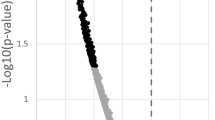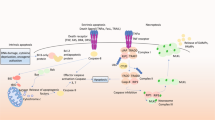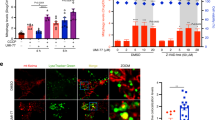Abstract
Toxicity of the typical antipsychotic haloperidol (HAL) comprises an apoptotic component that we link to pro-apoptotic Bcl-XS in PC12 preneuronal and N2a neuroblastoma cells. The mitochondrial translocation of Bcl-XS and its interaction with the pore-forming voltage-dependent anion channel (VDAC) correlates with the redistribution of cytochrome c and the cleavage of Poly(ADP-ribose) polymerase. Haloperidol-induced apoptosis is mediated by the sigma2 (σ2) receptor system and does not involve the expected antagonism of the dopamine D2 receptor, nor is it influenced by Vitamin E- or p53/Bax-mediated events. Pathological relevance is demonstrated by the cytotoxic synergism between HAL and the Alzheimer disease-related peptide β-amyloid(1–40), which correlates with Bcl-XS expression and its interaction with VDAC, and with cytosolic cytochrome c translocation. These data provide for a unique apoptotic mechanism that could underscore the clinical risks associated with HAL, particularly following chronic regimens or in the elderly.
This is a preview of subscription content, access via your institution
Access options
Subscribe to this journal
Receive 6 print issues and online access
$259.00 per year
only $43.17 per issue
Buy this article
- Purchase on Springer Link
- Instant access to full article PDF
Prices may be subject to local taxes which are calculated during checkout







Similar content being viewed by others
Abbreviations
- HAL:
-
haloperidol
- DTG:
-
1,3-di-o-tolylguanidine
- SKF:
-
SKF 10,047 [(+)N-allyl-normetazocine]
- PARP:
-
poly(ADP-ribose) polymerase
- VDAC:
-
voltage-dependent anion channel
- Aβ40:
-
β-amyloid(1–40)
- MTT:
-
3-(4,5-Dimethylthiazol-2-yl)-2,5-diphenyl tetrazolium
References
Wyatt RJ, Damiani LM, Henter ID . First-episode schizophrenia. Early intervention and medication discontinuation in the context of course and treatment. Br J Psychiatry 1998; 172: 77–83.
Lieberman JA, Tollefson GD, Charles C, Zipursky R, Sharma T, Kahn RS et al. Antipsychotic drug effects on brain morphology in first-episode psychosis. Arch Gen Psychiatry 2005; 62: 361–370.
Dewey KJ, Fibiger HC . The effects of dose and duration of chronic pimozide administration on dopamine receptor supersensitivity. Naunyn Schmiedebergs Arch Pharmacol 1983; 322: 261–270.
Galili-Mosberg R, Gil-Ad I, Weizman A, Melamed E, Offen D . Haloperidol-induced neurotoxicity – possible implications for tardive dyskinesia. J Neural Transm 2000; 107: 479–490.
Bowen WD . σ-Receptors: recent advances and new clinical potentials. Pharm Acta Helv 2000; 74: 211–218.
Quirion R, Bowen WD, Itzhak Y, Junien JL, Musacchio JM, Rothman RB et al. A proposal for the classification of σ binding sites. Trends Pharmacol Sci 1992; 13: 85–86.
Hayashi T, Su TP . σ-1 receptor ligands: potential in the treatment of neuropsychiatric disorders. CNS Drugs 2004; 18: 269–284.
Su TP, London ED, Jaffe JH . Steroid binding at sigma receptors suggests a link between endocrine, nervous, and immune systems. Science 1988; 240: 219–221.
Boyer EW . Dextromethorphan abuse. Pediatr Emerg Care 2004; 20: 858–863.
Gil-Ad I, Shtaif B, Shiloh R, Weizman A . Evaluation of the neurotoxic activity of typical and atypical neuroleptics: relevance to iatrogenic extrapyramidal symptoms. Cell Mol Neurobiol 2001; 21: 705–716.
Crawford KW, Bowen WD . σ-2 receptor agonists activate a novel apoptotic pathway and potentiate antineoplastic drugs in breast tumor cell lines. Cancer Res 2002; 62: 313–322.
Vilner BJ, Bowen WD . Modulation of cellular calcium by σ-2 receptors: release from intracellular stores in human SK-N-SH neuroblastoma cells. J Pharmacol Exp Ther 2000; 292: 900–911.
Chan SL, Yu VC . Proteins of the bcl-2 family in apoptosis signalling: from mechanistic insights to therapeutic opportunities. Clin Exp Pharmacol Physiol 2004; 31: 119–128.
Lindenboim L, Yuan J, Stein R . Bcl-xS and Bax induce different apoptotic pathways in PC12 cells. Oncogene 2000; 19: 1783–1793.
Lindenboim L, Schlipf S, Kaufmann T, Borner C, Stein R . Bcl-x(S) induces an NGF-inhibitable cytochrome c release. Exp Cell Res 2004; 297: 392–403.
Wei Z, Mousseau DD, Richardson JS, Dyck LE, Li XM . Atypical antipsychotics attenuate neurotoxicity of β-amyloid (25–35) by modulating Bax and Bcl-X(L/S) expression and localization. J Neurosci Res 2003; 74: 942–947.
Post A, Holsboer F, Behl C . Induction of NF-κB activity during haloperidol-induced oxidative toxicity in clonal hippocampal cells: suppression of NF-κB and neuroprotection by antioxidants. J Neurosci 1998; 18: 8236–8246.
Post A, Rucker M, Ohl F, Uhr M, Holsboer F, Almeida OF et al. Mechanisms underlying the protective potential of α-tocopherol (vitamin E) against haloperidol-associated neurotoxicity. Neuropsychopharmacology 2002; 26: 397–407.
Martinou JC, Green DR . Breaking the mitochondrial barrier. Nat Rev Mol Cell Biol 2001; 2: 63–67.
Musacchio JM, Klein M, Paturzo JJ . Effects of dextromethorphan site ligands and allosteric modifiers on the binding of (+)-[3H]3-(-3-hydroxyphenyl)-N-(1-propyl)piperidine. Mol Pharmacol 1989; 35: 1–5.
Walker JM, Bowen WD, Walker FO, Matsumoto RR, De Costa B, Rice KC . Sigma receptors: biology and function. Pharmacol Rev 1990; 42: 355–402.
Hellewell SB, Bowen WD . A sigma-like binding site in rat pheochromocytoma (PC12) cells: decreased affinity for (+)-benzomorphans and lower molecular weight suggest a different sigma receptor form from that of guinea pig brain. Brain Res 1990; 527: 244–253.
Gilmore DL, Liu Y, Matsumoto RR . Review of the pharmacological and clinical profile of rimcazole. CNS Drug Rev 2004; 10: 1–22.
Devanand DP, Marder K, Michaels KS, Sackeim HA, Bell K, Sullivan MA et al. A randomized, placebo-controlled dose-comparison trial of haloperidol for psychosis and disruptive behaviors in Alzheimer's disease. Am J Psychiatry 1998; 155: 1512–1520.
Mousseau DD, Chapelsky S, De Crescenzo G, Kirkitadze MD, Magoon J, Inoue S et al. A direct interaction between transforming growth factor (TGF)-βs and amyloid-β protein affects fibrillogenesis in a TGF-β receptor-independent manner. J Biol Chem 2003; 278: 38715–38722.
Waddington JL, Kapur S, Remington GJ . The neuroscience and clinical psychopharmacology of first- and second-generation antipsychotic drugs. In: Hirsch SR, Weinberger DR (eds). Schizophrenia, 2nd edn. Blackwell Science: Oxford, 2003, pp 421–441.
Hanner M, Moebius FF, Flandorfer A, Knaus HG, Striessnig J, Kempner E et al. Purification, molecular cloning, and expression of the mammalian σ1-binding site. Proc Natl Acad Sci USA 1996; 93: 8072–8077.
Korpi ER, Kleinman JE, Costakos DT, Linnoila M, Wyatt RJ . Reduced haloperidol in the post-mortem brains of haloperidol-treated patients. Psychiatry Res 1984; 11: 259–269.
Vilner BJ, de Costa BR, Bowen WD . Cytotoxic effects of σ ligands: σ receptor-mediated alterations in cellular morphology and viability. J Neurosci 1995; 15: 117–134.
Brent PJ, Pang G, Little G, Dosen PJ, Van Helden DF . The sigma receptor ligand, reduced haloperidol, induces apoptosis and increases intracellular-free calcium levels [Ca2+]i in colon and mammary adenocarcinoma cells. Biochem Biophys Res Commun 1996; 219: 219–226.
Braun T, Dar S, Vorobiov D, Lindenboim L, Dascal N, Stein R . Expression of Bcl-x(S) in Xenopus oocytes induces BH3-dependent and caspase-dependent cytochrome c release and apoptosis. Mol Cancer Res 2003; 1: 186–194.
Yu SW, Wang H, Poitras MF, Coombs C, Bowers WJ, Federoff HJ et al. Mediation of poly(ADP-ribose) polymerase-1-dependent cell death by apoptosis-inducing factor. Science 2002; 297: 259–263.
Vander Heiden MG, Thompson CB . Bcl-2 proteins: regulators of apoptosis or of mitochondrial homeostasis? Nat Cell Biol 1999; 1: E209–E216.
Martinou JC, Desagher S, Antonsson B . Cytochrome c release from mitochondria: all or nothing. Nat Cell Biol 2000; 2: E41–E43.
Kuwana T, Mackey MR, Perkins G, Ellisman MH, Latterich M, Schneiter R et al. Bid, Bax, and lipids cooperate to form supramolecular openings in the outer mitochondrial membrane. Cell 2002; 111: 331–342.
Mitra RS, Benedict MA, Qian D, Foreman KE, Ekhterae D, Nickoloff BJ et al. Killing of sarcoma cells by proapoptotic Bcl-X(S): role of the BH3 domain and regulation by Bcl-X(L). Neoplasia 2001; 3: 437–445.
Lezoualc’h F, Rupprecht R, Holsboer F, Behl C . Bcl-2 prevents hippocampal cell death induced by the neuroleptic drug haloperidol. Brain Res 1996; 738: 176–179.
Brent PJ, Pang GT . σ binding site ligands inhibit cell proliferation in mammary and colon carcinoma cell lines and melanoma cells in culture. Eur J Pharmacol 1995; 278: 151–160.
Bermack JE, Debonnel G . Distinct modulatory roles of sigma receptor subtypes on glutamatergic responses in the dorsal hippocampus. Synapse 2005; 55: 37–44.
Gross A, Jockel J, Wei MC, Korsmeyer SJ . Enforced dimerization of BAX results in its translocation, mitochondrial dysfunction and apoptosis. EMBO J 1998; 17: 3878–3885.
Hinz M, Loser P, Mathas S, Krappmann D, Dorken B, Scheidereit C . Constitutive NF-κB maintains high expression of a characteristic gene network, including CD40, CD86, and a set of antiapoptotic genes in Hodgkin/Reed–Sternberg cells. Blood 2001; 97: 2798–2807.
Kawamura K, Kimura Y, Tsukada H, Kobayashi T, Nishiyama S, Kakiuchi T et al. An increase of σ receptors in the aged monkey brain. Neurobiol Aging 2003; 24: 745–752.
Reddy DS, Kaur G, Kulkarni SK . Sigma (σ1) receptor mediated anti-depressant-like effects of neurosteroids in the Porsolt forced swim test. NeuroReport 1998; 9: 3069–3073.
Beuzen JN, Taylor N, Wesnes K, Wood A . A comparison of the effects of olanzapine, haloperidol and placebo on cognitive and psychomotor functions in healthy elderly volunteers. J Psychopharmacol 1999; 13: 152–158.
Gil-Ad I, Shtaif B, Levkovitz Y, Dayag M, Zeldich E, Weizman A . Characterization of phenothiazine-induced apoptosis in neuroblastoma and glioma cell lines: clinical relevance and possible application for brain-derived tumors. J Mol Neurosci 2004; 22: 189–198.
Phan VL, Urani A, Sandillon F, Privat A, Maurice T . Preserved sigma1 (σ1) receptor expression and behavioral efficacy in the aged C57BL/6 mouse. Neurobiol Aging 2003; 24: 865–881.
Urani A, Romieu P, Roman FJ, Yamada K, Noda Y, Kamei H et al. Enhanced antidepressant efficacy of σ1 receptor agonists in rats after chronic intracerebroventricular infusion of β-amyloid-(1–40) protein. Eur J Pharmacol 2004; 486: 151–161.
Yao A, Nguyen TV, Pike CJ . β-Amyloid-induced neuronal apoptosis involves c-Jun N-terminal kinase-dependent downregulation of Bcl-w. J Neurosci 2005; 25: 1149–1158.
Acknowledgements
We thank Dr Rémi Quirion, Douglas Hospital Research Center, Montréal (Québec), and Dr Deborah Anderson, Saskatchewan Cancer Agency, for comments on the manuscript. This work was supported by the Saskatchewan Health Research Foundation (to DDM), by the Canadian Institutes of Health Research (CIHR; to XML) and by a post-doctoral Fellowship (to ZW) from the CIHR/Rx&D Research Program (200104DFE-91579-112515) and AstraZeneca/Alzheimer Society of Canada.
Author information
Authors and Affiliations
Corresponding author
Additional information
Duality of interest
None declared.
Rights and permissions
About this article
Cite this article
Wei, Z., Mousseau, D., Dai, Y. et al. Haloperidol induces apoptosis via the σ2 receptor system and Bcl-XS. Pharmacogenomics J 6, 279–288 (2006). https://doi.org/10.1038/sj.tpj.6500373
Received:
Revised:
Accepted:
Published:
Issue Date:
DOI: https://doi.org/10.1038/sj.tpj.6500373
Keywords
This article is cited by
-
Cannabinoids in the management of behavioral, psychological, and motor symptoms of neurocognitive disorders: a mixed studies systematic review
Journal of Cannabis Research (2022)
-
Ca2+ signaling as a mechanism of haloperidol-induced cytotoxicity in human astrocytes and assessing the protective role of a Ca2+ chelator
Naunyn-Schmiedeberg's Archives of Pharmacology (2020)
-
Sigma-2 receptor agonist derivatives of 1-Cyclohexyl-4-[3-(5-methoxy-1,2,3,4-tetrahydronaphthalen-1-yl)propyl]piperazine (PB28) induce cell death via mitochondrial superoxide production and caspase activation in pancreatic cancer
BMC Cancer (2017)
-
Haloperidol-loaded lipid-core polymeric nanocapsules reduce DNA damage in blood and oxidative stress in liver and kidneys of rats
Journal of Nanoparticle Research (2015)
-
The novel sigma-2 receptor ligand SW43 stabilizes pancreas cancer progression in combination with gemcitabine
Molecular Cancer (2010)



